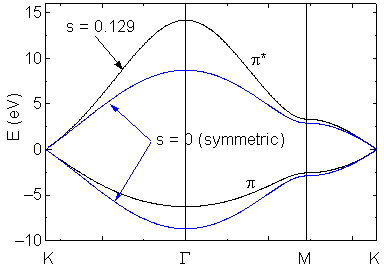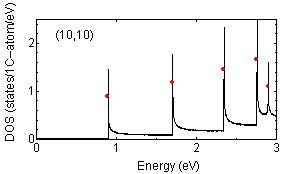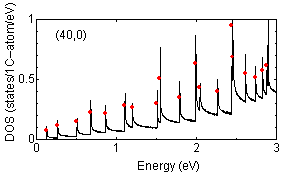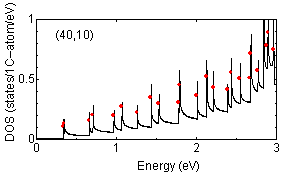Kataura plot was first introduced by Kataura et al. for the interpretation
of resonant Raman spectra.
H. Kataura, Y. Kumazawa, Y. Maniwa, I Umezu, S. Suzuki, Y. Ohtsuka and
Y. Achiba, Sythetic Metals 103 (1999), 2555-2558.
Later Saito et al. reported the detailed calculations of 1D electronic
DOS with van Hove singularity in the following paper.
R. Saito, G. Dresselhaus, and M. S. Dresselhaus, Trigonal warping
effect of carbon nanotubes, Physical Review B, vol. 61, no. 4, 2981 (2000).
All the detailed calculations are based on the above paper and you can
find all the details and accurate discussions in the paper.
For my new students, I am preparing some simple visual material to help
understanding of the paper. THIS IS UNDERCONSTRUCTION.
For the detailed discussions of Chirality and
symmetry Click here.
For the calculated table of important
parameters, Click here.
Hexagonal lattice in ordinal coordinates are summarized as below.


![]() ,
,

Now the reciprocal lattice vectors are defined as the figure below:

The conversions of base vectors are simply calculated as follows:
![]()

Brillouin Zone (central hexagonal area in the above figure) is expressed as follows:

Chiral Ch and Lattice T vectors are
transformed to K1 and K2 vectors as
follows:
![]() ,
, ![]()
![]() ,
, ![]()
Discrete unit vector along the circumferential direction:
![]()
Reciprocal lattice vector along the nanotube axis:
![]()
Letfs
check the following:


Note:
![]()
For a nanotube Brillouin Zone of graphite has
no meaning and the k-space we should considered is as follows:
![]() where
where 
Hence, 
For tables of those value up to (40,40) nanotubes, click here.
The 2 D energy dispersion relations of graphite are shown as below.
![]()

Overlap integral: s=0.129
Carbon-carbon
interaction energy: g0=2.9eV
e2p = 0

From: R. Saito, G. Dresselhaus, and M. S. Dresselhaus, Trigonal warping
effect of carbon nanotubes, Physical Review B, vol. 61, no. 4, 2981 (2000).
[Color picture was from Professor R.
Saito]
Or in the couture map of p and p* separately is shown as below:


If you plot the value along K -> G -> M -> K, the dispersion is expressed as below:

Asymmetry of conduction and valence bands is not important for the
calculation of the energy difference of conduction and valence bands
With s=0 and e2p = 0
The dispersion relations is simplified as follows:


Compared with the asymmetric dispersion relations, the energy difference of p and p* bands of symmetric approximation are almost the same for low DE range such as 6 eV.
Hence, we can conclude the effect of overlap integral is not important.
The following calculations of DOS were performed for this symmetric dispersion relation.

Examples of comparisons of DOS for armchair tubes

Examples of comparisons of DOS for zigzag tubes

The trigonal warping effect (see the paper by R. Saito)

Examples of peak position findings are shown below:
The determination of van Hove singularity position is rather
straightforward but the estimation of approximate height is more complicated.
The red solid circles are assigned peak position with approximate height
proportional to the strength of peaks.





